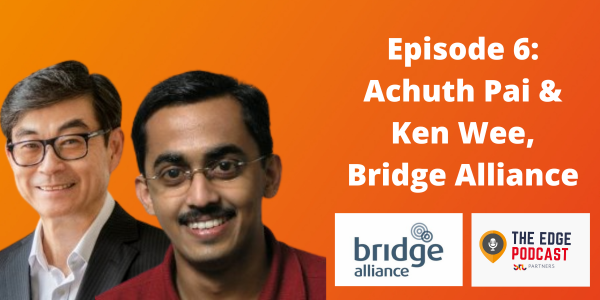
Ken Wee, our Senior Vice President, Alliance Partnership and Innovation and Achuth Pai, our Associate Director, Group Sourcing and Innovation Projects, were invited to STL Partners’ The Edge Podcast and spoke to Dalia Adib, its Director, Consulting on the topic of telco edge federation.
Listen to the podcast or read the transcript below.
Dalia: Before we get going on talking about Federated Edge, which is, I think the key topic I wanted to discuss with you guys today. Can you first introduce yourselves to the audience? Tell us a little bit about the Bridge Alliance as well. Ken, if you want a go?
Ken: Sure. Thank you Dalia. Thank you once again for inviting us. I am Ken Wee. I head up partnerships and innovation, I’m a Senior VP at Bridge Alliance. Bridge Alliance was formed back in 2004, and we are a joint venture company that’s owned by the telcos. Today we have 34 member operators within the Bridge Alliance. We focus on four different business pillars leveraging on our scale and geographical presence–roaming programme office, we look at providing enterprise services for multinational companies, we look at IoT and platform services across the region and we leverage on group scale for group sourcing. Last but not least, we are looking at innovation and 5G stuff that’s coming up.
So at Bridge, we understand that it’s important to simplify access for enterprises who are looking for simplicity in connectivity, whether it’s 5G edge or platform network services especially in Asia Pacific where the market is so fragmented. So we are currently working on some of the cool stuff like Federated Edge across multiple markets.
Dalia: Nice, good stuff and your role specifically?
Ken: I head up the Alliance Partnership and Innovation and I have a team that leads the 5G and Edge working group, that looks into these 5G and edge initiatives.
Dalia: And Pai, just a quick intro from you too?
Pai: I’m Achuth Pai, I’m part of Ken’s team as well. I help our member operators to drive innovation projects, mainly in 5G. And one of the platform projects that I’m driving currently is the Federated Edge Hub that we’re closely working with other operators and various industry partners.
Dalia: So that leads me to the next question, I think just if you can provide a bit of an overview, what Bridge Alliance is doing in edge. It sounds like it’s quite closely related to your 5G initiatives. How do you see the edge relationship with that, what do you see as your role?
Ken: If you look at what each telco is doing, telcos are very focused in their own boundaries, looking more at domestic use cases. But if you look at some of the multinational companies, or OEMs, they’d be looking at delivering edge services, or require edge compute services across multiple markets. So just imagine if there’s a need to coordinate or interface with multiple operators from different markets, it’s going to be very challenging for all these enterprises. So we do believe that it’s important that we make it simple for these enterprise customers who need to have edge resources across multiple markets.
At Bridge we are looking at building a Federated Edge Hub that will enable interconnection of each telco’s mobile edge cloud across multiple telcos and markets. So, in order to provide application partners and enterprise customers with a unified access to edge compute resources; with this federation, it will simplify edge resource discovery, ordering of edge resources, spinning up a virtual machine, and deployment of edge applications for multiple markets within the Bridge Alliance footprint and beyond.
Dalia: Cool. I mean that sounds like really what the industry set out to do right at the beginning when it comes to telco edge and I think we’ve always recognised that challenge that you can’t have isolated telco edges if this market’s going to grow, but great that you guys are kind of spearheading that. And Pai, I guess Ken has described almost like the end vision. I know you guys have been doing some projects with telcos, your Bridge Alliance members and others in the ecosystem like the GSMA. Could you talk a little bit about what you’re doing today about enabling that future vision?
Pai: Yes. We started this journey, a couple of years back, working closely with our member operators Singtel and SK Telecom. So, right at the onset, we decided to adopt an architecture which is based on the open principles as well as using micro-services to develop some of the capabilities within our FEH and this was important. Why? Because at that time, MEC was still evolving and we wanted to ensure that we had the right architecture in place to quickly adapt to changing market needs, as well as new requirements from our customers.
So the first phase was jointly developed by Singtel and SK Telecom. We also adopted open interfaces such as TMForum and ETSI, which is to ensure that we keep open principles and open architecture approach and upon completion of that we did quick validation just to ensure that we’re building in line with the market needs. So we did validate with some of the gaming partners such as Gameye and Gamegrid.
Since then we have been engaging various industry partners. One of our key engagements is with GSMA Telco Edge Cloud Forum where they are defining a framework for operator platform for edge and they’re also developing different standards and APIs. For example, one of the recent work that they’re doing is with Linux Foundation, codenamed project CAMARA. They’re trying to define APIs which are developer-centric and industry-standard based.
I think this approach around standardisation is really important. That’s what, within Bridge Alliance, we’re also trying to drive, because we want to ensure that telcos are able to interconnect their edge compute rapidly, to build the scale to entice these edge developers and application partners to come on board, and to start building applications which are native to edge.
Dalia: Yeah, that’s cool and I went to an event around edge computing recently and one of the points that an edge platform business that enables ISVs was saying that there’s at the moment, we need more edge, we need more capacity, we need the ability to access those edges. So, it sort of falls into that. I’m just thinking, so the GSMA is defining these frameworks and APIs. So is the idea that you would take some of those and you’re importing some of those developments, you’re taking that to be incorporated in FEH, which is Federated Edge Hub. That’s the idea for your platform?
Pai: That’s correct. As I mentioned, some of these interfaces are still developing. It’s a two-way approach. In fact, we had multiple phases of the POC. The Phase One was to essentially interconnect the two markets, Singapore and South Korea, which is the Singtel and SKT MEC. There were some learnings coming out of that which was given as feedback to the GSMA Forum.
Phase two involved interconnecting with an additional partner, in this case Telefonica using a hub-to-hub architecture. Some of the learnings coming out of that was shared with GSMA forum as well. Eventually, some of these will be incorporated when the (API) standardisation happens. The main two areas where we’re focusing are the set of APIs that will be given to the developer community, application partners and edge interconnection with telcos. We want to ensure that they’re using something which is already available and used by developers rather than trying to reinvent the wheel. So that’s where I think the close collaboration with the industry members is important.
Dalia: That’s cool. And these APIs are mainly about being able to kind of set up working codes at an edge or will that be done by the operators’ own telco edge platforms? Or is it more about monitoring usage on different edge platforms…what are some of those APIs doing?
Pai: So in fact the operator platform defines different set of interfaces/. In terms of interconnection between the different telco edge cloud platforms, the set of APIs is mainly to discover and order each other’s edge compute resources. In our case, in the FEH we do have that capability as well where they are able to pick up the inventory from different markets, able to aggregate that and make it available to the application partners. The second set of APIs is for the north-bound which GSMA is defining. These are the set of APIs that will be available to the developers to discover and order the edge compute resources. They’ll be able to spin up the virtual machines or even containers if they want to deploy in a micro services application as well.
Dalia: Okay. That sort of heads up my next question, which is how you’re starting to envision a commercial model around this. So it sounds like maybe there are two…but I’ll leave it to you to say what you think is right? I mean, I think all these things that you say are in evolution but do you know what’s the current thinking with some of the Bridge Alliance members around what the commercial models could be?
Pai: So that’s something which we are trying to grasp as well, just to be open here. But essentially, there are two parts to the commercial model. One is, how do we offer the edge compute? Specifically, the Federated Edge cloud, to the customers, be it the application partners or MNC enterprises, that’s the first part. The second part is, what is the model between the telcos? How do we settle this?
So, starting with the first, in terms of the model with our customers, we think it will largely follow the existing cloud-based models right, be it the Pay-As-You-Go charging model, or even the reservations model, which is what I think most of the hyperscalers are offering. And here there has to be an effort in terms of standardising the catalogue in terms of compute storage and GPUs, across the market, because partners will typically need a similar set of catalogue across the market. So it will largely follow the existing hyperscaler model.
In terms of the second area, the inter-telco model, there is a lot of discussion happening in the GSMA Telco Cloud Forum as well, in terms of what the models are, what are the different kind of commercial templates between the telcos. We are thinking most likely in the coming months there’ll be some outcome as part of that discussion as well.
Dalia: To what extent can you leverage some of the work that you’ve done around roaming, are you taking some of those models and applying them, can you use some of the standards or less so, given that it’s compute rather than mobile connectivity?
Pai: I think so. In fact, there are already discussions with the roaming group, the WAS group, (the wholesale agreement and the solutions) where they are trying to incorporate learnings from the roaming side as well. But again, from our perspective, I think the models have to evolve because here when it comes to edge computing there are a lot more partners involved, you have the telcos, you have the enterprises, you have the application partners.
What we’ve been hearing from some of the partners, the application partners specifically, they think that there has to be an element of cooperation in terms of the retail offering and how this is quickly settled among the different telcos. So, I think there can be learnings from the traditional approaches, but of course, we have to adapt based on the current market needs.
Dalia: Yeah, I guess roaming has taken a long time to become automated in terms of assessment. So it’s in some ways kind of refreshing to start from scratch. Cool. So, Ken sounds like lots going on in the group and lots of different moving parts to figure out technology, the commercial side and what each party does. So what’s next then for the project and the next few months for you guys?
Ken: For this year, we have got a couple of things that we are focusing on. The first is to quickly set up a testbed so that we can onboard those application partners who have real and deployable applications that require edge cases. We will allow our partners to conduct a few trials in the live 5G network environment across multiple markets. Second thing, as what Pai mentioned earlier, is really, to look at our member operators, look at how we can explore together for commercial models to enable these edge applications in our market.
So this is an open invitation to the partners out there! We’re inviting edge application partners who have deployment-ready, commercial edge use cases to reach out to us. We’re happy to conduct these tests together with those partners.
Dalia: Nice! Sounds exciting. And that lab is going to be in Singapore, is that right?
Ken: Yes.
Dalia: That’s exciting times coming up. Yeah, thanks so much guys. That’s the end of our short podcast. I learned quite a bit – even though we speak quite a lot, I’ve learned a lot more in the last ten minutes. Thanks so much Pai and Ken for giving us that overview of what’s to come. Next steps, it’ll be great to keep in touch on how things are going on the Federated Edge Hub. At least from my perspective, we’re seeing a lot more real traction and investment from the telecoms operators to enable a kind of telco edge model given that, you know, the last few years has been more of a cloud provider-centric approach. So I think that would be cool to see what happens next and hopefully, you know, driven by some of the what you guys are doing.
Pai: Thank you so much Dalia for having us on this podcast.



